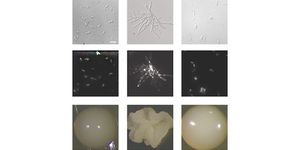Improving Immunotherapy with a Novel Nanoparticle
Malignant pleural effusion (MPE) occurs in cancer patients experiencing a buildup of fluid and tumor cells in the pleural cavity, the area between the chest wall and lungs. While various types of cancer can cause MPE, it is most common in women with breast cancer and men with lung cancer. Still, cases also develop in patients with lymphoma and cancers of the genitourinary and gastrointestinal tracts.
Despite many beneficial advances in treating primary cancer, the prognosis for patients with MPE remains poor, with median survival ranging from 3 to 12 months post-diagnosis. Many clinical factors influence an individual’s prognosis, including the underlying cancer type, the progression of the primary tumor, and the patient’s comorbidities.
Because MPE presents with late-stage disease, treatment is primarily palliative, aiming to improve the quality of life for patients suffering from this malignancy. Treating MPE is challenging because both fluid and tumor cells prevent efficient drug delivery, so there is a critical need for more unique therapeutic options. Researchers are looking to immune checkpoint inhibitors (ICIs) to bring some clinical benefit to patients suffering from MPE.
Recent clinical trials suggest that MPE may be susceptible to ICI approaches; however, only a small subset of patients experience clinical benefit. A new study published in Nature Nanotechnology demonstrates a new technology that could greatly increase the number of MPE patients who respond favorably to ICI treatment.
The researchers capitalized on previous observations noting the accumulation of immunosupressive cells, which inhibit the anti-tumor immune response, in the pleural cavity of MPE patients. The researchers developed a nanoparticle named liposomal cyclic dinucleotide (LNP-CDN) to address this therapeutically.
LNP-CDN targets a critical immune pathway called stimulator of interferon genes (STING). The study demonstrated that activation of STING by LNP-CND reprogramed immune cells, which suppress anti-tumor immunity to active tumor-fighting immune cells. In addition, LNP-CND promoted the expansion of CD8+ effector T cells, a subset of anti-tumor immune cells integral for cancer cell killing.
The study also showed that LNP-CDN significantly enhanced the efficacy of an ICI, which blocks the programmed death-ligand 1 (PD-L1) pathway. When combined with anti-PD-L1 therapy, LNP-CDN suppressed the growth of tumors in the pleural cavity of mice with MPE. Additionally, this combination approach reduced the volume of fluid in mice with MPE. Notably, the mice treated with anti-PD-L1 and LNP-CDN demonstrated prolonged survival compared to those receiving either therapeutic component alone.
The study concluded by demonstrating that LNP-CDN promoted an anti-tumor environment, including activated CD8+ effector T cells, in MPE samples extracted from patients. This evidence strongly supports the need for further investigation of LNP-CDN in MPE clinical trials.
Sources: Am Thoracic Soc, Thorax, J Thoracic Disease, JAMA Oncology, Nature Nanotechnol, Oncoimmunology, J Hemat Oncol









